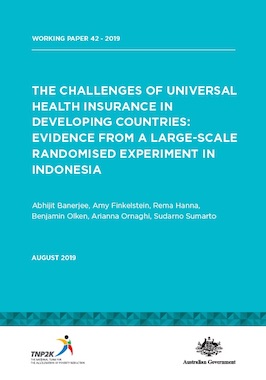The Challenges of Universal Health Insurance in Developing Countries Evidence from a Large-Scale Randomised Experiment in Indonesia
To assess ways to achieve widespread, financially sustainable health insurance coverage in developing countries, we designed a randomised experiment involving almost 6,000 households in Indonesia who are subject to a nationally mandated government health insurance program (Jaminan Kesehatan Nasional: JKN). We assessed several interventions that simple theory and prior evidence suggest could increase coverage and reduce adverse selection: (i) substantial temporary price subsidies (which had to be activated within a limited time window and lasted for only a year); (ii) assisted registration; and (iii) information. Both temporary subsidies and assisted registration increased initial enrolment.
Temporary subsidies attracted lower-cost enrollees, in part by eliminating the practice observed in the no-subsidy group of strategically timing coverage for a few months during health emergencies. As a result, while subsidies were in effect, they increased coverage more than eightfold at no higher unit cost. Even after the subsidies ended, coverage remained twice as high–again at no higher unit cost. However, the most intensive (and effective) intervention, however–assisted registration and a full one-year subsidy–resulted in only a 30 percent initial enrolment rate, underscoring the challenges to achieving widespread coverage.
